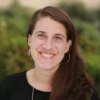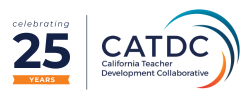Applying CATDC Practices of Learning and Leading to your own School Community

Over the past decade we, Cathy Aragon, Meredith Landis and Sylvia Rodriguez Douglass, have individually learned from many workshops and conferences provided by the CATDC. In the last year we found ourselves drawn into conversation, reflecting on what we brought away from these professional learning opportunities and recognizing the major themes in our work that we want to continue to pursue together.
As full-time, over-scheduled teaching professionals it can feel impossible to find time to strategize about ways to make positive change in our schools. We use conferences or workshops as a place to escape and find a quiet moment of introspection and productive thought. Through participating in four different CATDC programs (TALL Change, Leadership 101, Leaders of Color, and Women in Leadership), we three colleagues gained a great deal and realized were able to bring our thinking back to our school to continue the conversations. It felt as if we had been given permission to expand outside of our roles and consider how to pull these different threads of conversation together into one central idea for positive change that works for our school.
Meredith Landis
I attended the CATDC’s Women in Leadership conference because I was feeling the itch to move beyond my role of classroom teacher, and to see what options there might be for someone in my position to “lead” in a school setting. What I discovered during this day was so much more invigorating and long-lasting than I had anticipated. I found a community of like-minded women who are seeking inspiration and rejuvenation as we pursue the many projects we are all managing. As Reveta Bowers reminded us at the conference, it’s not about finding balance, it’s about managing the imbalance in our lives and careers. I found empathy and understanding for the position so many of us are in, and I also learned tangible and direct tools for moving forward not just in my career, but also in my personal growth.
One inspiring idea I took with me was that we all benefit from mentors, and we can find mentorship in our peers. Equally intriguing and motivating was the idea that we can act as mentors for our peers in return. This notion that I was already imbued with the skills to offer others guidance and that I did not need to look further than the table at which I was seated for a support system was a game-changer. I walked out of the one-day workshop with a list of to-do items including the participant email list where I had marked the names of all of the people I planned to reach out to in the hopes of forming a peer mentor group. One of the people on that list was Cathy, who was also excited by what we had learned during our day at Women in Leadership.
Not surprisingly, the moment I returned to my classroom I was consumed with catching up, grading, and checking in with all my students. I felt my motivation quickly seeping away. Not much later, Cathy followed up with me and pulled in Sylvia. Both of these determined women had experienced similar feelings of eagerness, inspiration and then disappointment at the prospect of trying to continue the work solo. We realized that we didn’t need to consult the email list of attendees, we had our peer mentor group right here. We have different roles and immediate goals, but our support and mutual mentorship have helped us each to develop the confidence and clarity to continue working toward our personal and group goals.
Cathy Aragon
TALL Change, one of the CATDC’s ongoing programs, has given me the tools to navigate instructional change in a time of great transitions. One of my most powerful takeaways is the notion of soft power. Soft power is a concept mostly applied to international relations, but it has a place in school organizations as well. It is the power to affect change by leveraging relationships and using persuasion over coercion. As teacher leaders, while we may not always be in decision-making positions, we have the ability to use soft power to influence decisions. I took this idea of soft power back to my school as a reminder that I, and my colleagues, have more agency than we once believed. Through conversations, I have been able to elevate the voices of different constituents and connect diverse perspectives.
I have coupled what I have learned from TALL Change with Leadership 101, another ongoing program, geared towards leaders in their first years. I learned about StrengthsFinder, a tool produced by Gallup to help one find their strengths and information about how to leverage those strengths in their career. I also learned how to have hard conversations with others, the importance of norms to support effective collaboration, and how to run effective and productive meetings. These tools and strategies have helped play a role in wielding soft power in order to create transformational change.
While I was on my own quest to refine and strengthen my leadership skills, I attended the CATDC’s Women in Leadership Conference. There, while sitting next to Meredith, we struck up a conversation in which I discovered we shared similar feelings about wanting to make changes in our schools and not knowing how. That conversation sparked more conversations, and we quickly brought Sylvia on board. Suddenly, I not only had ideas, but I had a cohort of women leaders with whom I could share ideas and collaborate to make a change.
Sylvia Rodriguez Douglass
Last year, a colleague of mine encouraged me to sign up for the CATDC’s Leaders of Color ongoing program. My first response was, “Really? Why me?” As a learning specialist at my school, I didn’t necessarily see myself as a leader. Despite my personal commitment to diversity and inclusion in independent schools, I questioned whether or not a cohort dedicated to leaders of color would even be the right fit for me. Thankfully, my colleague sensed my hesitation, and after some strong words of encouragement coupled with a dash of well, let’s just see what happens, I went ahead and signed up. I am so grateful that I did.
Through multiple, day-long meetings over the course of the year, I was able to reconstruct my definition of leadership. From the onset, I recognized that one of the benefits of this particular program, like so many from the CATDC, was that our facilitators were exemplary. Alison Park and Steve Morris made it clear to us that their intent was not to prime us to become heads of schools or division leaders. Rather, we were inspired to follow our own paths guided by our individual sense of leadership and professional aspirations. A range of guest speakers reinforced this message of navigating the journey according to my personal set of core values and beliefs. I quickly realized how unique this experience was to participate in a small cohort of like-minded leaders of color, inspired by mentors who could truly empathize and lead with such eloquence. The support of the Leaders of Color cohort instilled in me a confidence to pursue more leadership opportunities at my school as well as the capacity to form partnerships with equally motivated colleagues in my community.
Eager to keep the embers of motivation burning, I began regularly dialoguing with my colleague Cathy Aragon. This partnership evolved into something even greater when she approached me with a proposition: she had just attended the Women in Leadership Conference with Meredith Landis, our incredibly talented 8th-grade English teacher, and the two had struck upon a natural partnership. Inspired by our time at different CATDC workshops, the three of us joined forces to address some of the needs we were seeing within our community.
While our nascent group is just getting started, there is no doubt that the genesis of our collaboration is thanks, in large part, to the work we did off campus during our time at CATDC workshops. These programs provided the catalyst all three of us needed to identify our individual strengths and aspirations, recognize our capacity to leverage these in pursuit of short-term and long-term goals and appreciate the need to create networks to support one another in the process.
 Cathy Aragon is the Lower School Universal Design for Learning Coach at San Francisco Day School. Before becoming an instructional coach, she taught in early elementary classrooms for thirteen years in both private and public schools in San Francisco. She received her multiple subject credential from the Bay Area Teacher Training Institute and holds a BA in History from Harvard University.
Cathy Aragon is the Lower School Universal Design for Learning Coach at San Francisco Day School. Before becoming an instructional coach, she taught in early elementary classrooms for thirteen years in both private and public schools in San Francisco. She received her multiple subject credential from the Bay Area Teacher Training Institute and holds a BA in History from Harvard University.
 Meredith Landis is the 8th-grade English teacher and co-coordinator of the 8th-grade culminating project, Celebr8, at San Francisco Day School. She has worked in private schools around the Bay Area for the past ten years. She holds her BA from Cornell University and an MA in Teaching of English from Teacher’s College at Columbia University.
Meredith Landis is the 8th-grade English teacher and co-coordinator of the 8th-grade culminating project, Celebr8, at San Francisco Day School. She has worked in private schools around the Bay Area for the past ten years. She holds her BA from Cornell University and an MA in Teaching of English from Teacher’s College at Columbia University.
 Sylvia Rodriguez Douglass is the Upper School Universal Design for Learning Coach at San Francisco Day School. Her background is in special education, and she has been both a learning specialist and special educator for the past nine years in private and public schools in San Francisco and New York City. She holds an MA in Special Education from Hunter College and a BA in Childhood Education & Special Education from NYU.
Sylvia Rodriguez Douglass is the Upper School Universal Design for Learning Coach at San Francisco Day School. Her background is in special education, and she has been both a learning specialist and special educator for the past nine years in private and public schools in San Francisco and New York City. She holds an MA in Special Education from Hunter College and a BA in Childhood Education & Special Education from NYU.
